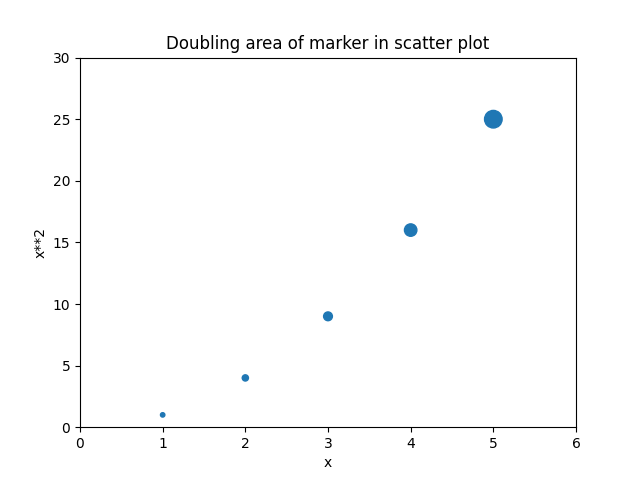

Plt.scatter(x,*len(x),s=s_square, label='$s=n^2$') Matplotlib: Change Scatter Plot Marker Size - Python ) fig, ax plt.subplots(figsize(10, 6)) ax.scatter(x df ) fig, ax plt.subplots(figsize(10, 6)) ax. The following is definition of scatter () function with s parameter, at third position, whose default value is None. Plt.scatter(x,*len(x),s=s_exp, label='$s=2^n$', lw=1) To set specific size for markers in Scatter Plot in Matplotlib, pass required sizes for markers as list, to s parameter of scatter () function, where each size is applied to respective data point. Thus if we want a circle to appear a factor of n bigger we would increase the area by a factor n not the radius so the apparent size scales linearly with the area.Įdit to visualize the comment by is what it looks like for different functions of the marker size: However it is the second example (where we are scaling area) that doubling area appears to make the circle twice as big to the eye.

Similarly the second example each circle has area double the last one which gives an exponential with base 2. The question asked about doubling the width of a circle so in the first picture for each circle (as we move from left to right) it's width is double the previous one so for the area this is an exponential with base 4. Now the apparent size of the markers increases roughly linearly in an intuitive fashion.Īs for the exact meaning of what a 'point' is, it is fairly arbitrary for plotting purposes, you can just scale all of your sizes by a constant until they look reasonable.Įdit: (In response to comment from probably confusing wording on my part. If instead we have # doubling the area of markers To set specific size for markers in Scatter Plot in Matplotlib, pass required sizes for markers as list, to s parameter of scatter () function, where each size is applied to respective data point. Notice how the size increases very quickly. To see this consider the following two examples and the output they produce. Because of the scaling of area as the square of width, doubling the width actually appears to increase the size by more than a factor 2 (in fact it increases it by a factor of 4). There is a reason, however, that the size of markers is defined in this way. This means, to double the width (or height) of the marker you need to increase s by a factor of 4. This can be a somewhat confusing way of defining the size but you are basically specifying the area of the marker.


 0 kommentar(er)
0 kommentar(er)
